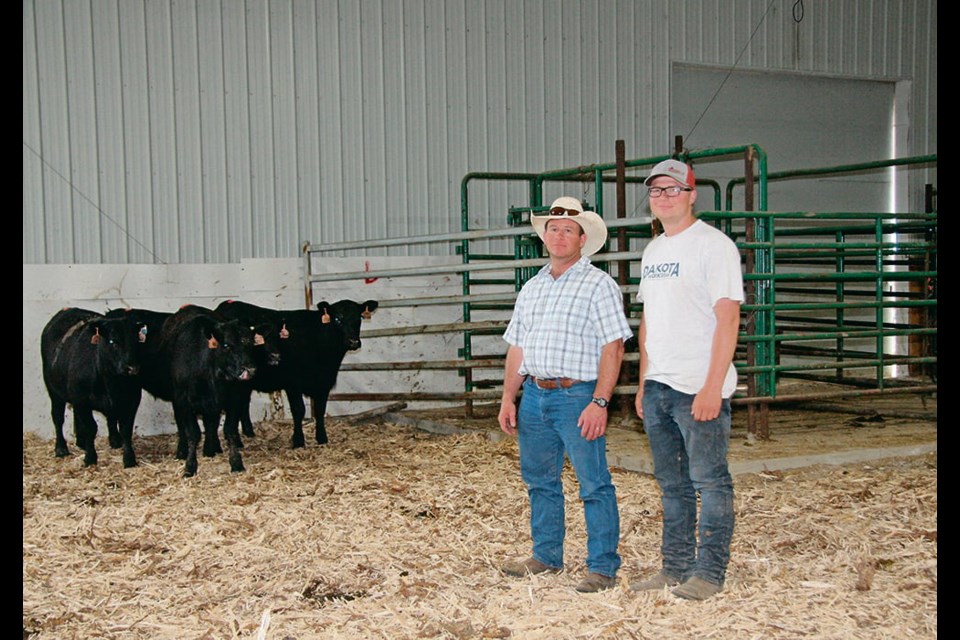PEEBLES, Sask. — A project underway on a Saskatchewan farm is testing technology that determines when a cow is in heat.
SenseHub Cow-Calf is new for the beef sector, although the dairy industry has used the technology for a while.
Dr. Sam Wauer, associate director of cattle veterinary services at Merck Animal Health, said an Allflex Sense Hub ear tag placed in a female at least two weeks before she is due to be bred will collect data 24-7.
The tag establishes a baseline from movement and behaviour data points, and a change in that baseline indicates the optimum breeding window. The producer’s phone will receive an alert and the ear tag will flash when that occurs.
The animal is usually bred through artificial insemination and then turned out with the bulls as well, Wauer said.
He said while many producers pride themselves on their ability to determine when a cow is in heat, the technology offers more precision.
Producers often check their animals morning and night, but have many other things to do in spring. The tags can save them and hired workers time.
And, they work in those females that have silent heat.
D and N Livestock at Peebles in the province’s southeast used 100 SenseHub Cow-Calf ear tags earlier this year as part of the Agriculture Demonstration of Practices and Technology (ADOPT) project in collaboration with the Saskatchewan Stock Growers Association.
The family-operated business runs about 1,400 Black Angus cows and breeds about 1,000 heifers to sell as replacements at its annual fall sale.
Dave Rajotte said they have been using Estrotect stickers on their heifers, which turn orange when the animal is in heat.
This spring, they tried 100 Sense Hub tags, along with the stickers, as part of the ADOPT project.
Rajotte said he found it helpful to attach the ear tags during pre-breeding vaccinations when the animals were already in the chutes.
“You don’t have to run the heifers in and put the stickers on” at a later time, he said during a demonstration day at the farm earlier this summer.
He said the tags appeared to be working well, although the conception rate wasn’t yet known.
His son, Carlin Rojotte, said they had confidence in the system and liked the fact that peak heat was customized to each individual animal.
“I got an alert on my phone at 3 a.m.,” he said. “The light was flashing when I got there.”
Both Rajottes said they were interested in where else this type of technology could work. For example, Dave said identifying a particular animal would make sorting easier and Carlin said knowing when a cow is going to calve would also help.
The tags are removed after the animals are bred because they can be re-used for several years.
Wauer said most producers would probably use the tags when they are planning to artificially inseminate females to top sires.
He said the ADOPT project was undertaken to show how the technology could be used by larger producers.
Dave Rajotte said they installed Star Link internet in their large barn where they also hold their on-farm sales to ensure good service between the tags and the reader. The reader that receives the information is on the outside and good to about a 300-metre distance.
Wauer said it is possible to extend that distance with extra stations as long as power is available.
Rajotte said the heat-detection patches are much cheaper in terms of upfront cost, but he said the potential to increase conception rates and save labour costs is huge.
There is a cost for the tags and a yearly cost for activation, including software and tech support.
“Like any technology, we probably don’t know the true cost until we come out the other side,” Rajotte said. “But even a five percent increase in conception rate would pay for it.”
The project is also comparing how the tags perform compared to the stickers.
Wauer said the tags should increase reproductive performance, especially for high-end genetics, increase the conception rate, result in heavier fall calves and allow more time to rebreed.
“Then there’s the labour efficiency,” he said. “You can never have enough people on the farm.”
You can no longer count on social media to deliver important news to you. Keep your news a touch away by bookmarking SASKTODAY.ca's homepage at this link.
Subscribe to SASKTODAY.ca newsletter to get our daily news to your inbox.


